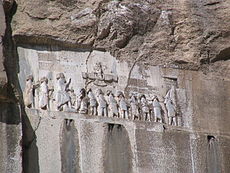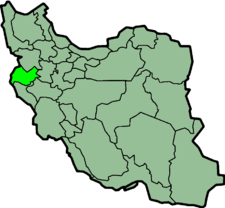
Behistun Inscription
About this schools Wikipedia selection
This Schools selection was originally chosen by SOS Children for schools in the developing world without internet access. It is available as a intranet download. All children available for child sponsorship from SOS Children are looked after in a family home by the charity. Read more...
34°23′18″N 47°26′12″E
| Bisotun | |
|---|---|
| Name as inscribed on the World Heritage List | |
 |
|
| Country | |
| Type | Cultural |
| Criteria | ii, iii |
| Reference | 1222 |
| UNESCO region | Asia-Pacific |
| Inscription history | |
| Inscription | 2006 (30th Session) |
The Behistun Inscription (also Bisitun or Bisutun, Modern Persian: بیستون ; Old Persian: Bagastana, meaning "the god's place or land") is a multi-lingual inscription located on Mount Behistun in the Kermanshah Province of Iran, near the town of Jeyhounabad.
The inscription includes three versions of the same text, written in three different cuneiform script languages: Old Persian, Elamite, and Babylonian. A British army officer, Henry Rawlinson, had the inscription transcribed in two parts, in 1835 and 1843. Rawlinson was able to translate the Old Persian cuneiform text in 1838, and the Elamite and Babylonian texts were translated by Rawlinson and others after 1843. Babylonian was a later form of Akkadian: both are Semitic languages. In effect, then, the inscription is to cuneiform what the Rosetta Stone is to Egyptian hieroglyphs: the document most crucial in the decipherment of a previously lost script.
The inscription is approximately 15 metres high by 25 metres wide, and 100 metres up a limestone cliff from an ancient road connecting the capitals of Babylonia and Media ( Babylon and Ecbatana). It is extremely inaccessible as the mountainside was removed to make the inscription more visible after its completion. The Old Persian text contains 414 lines in five columns; the Elamite text includes 593 lines in eight columns and the Babylonian text is in 112 lines. The inscription was illustrated by a life-sized bas-relief of Darius, holding a bow as a sign of kingship, with his left foot on the chest of a figure lying on his back before him. The prostrate figure is reputed to be the pretender Gaumata. Darius is attended to the left by two servants, and ten one-metre figures stand to the right, with hands tied and rope around their necks, representing conquered peoples. Faravahar floats above, giving his blessing to the king. One figure appears to have been added after the others were completed, as was (oddly enough) Darius' beard, which is a separate block of stone attached with iron pins and lead.
In ancient history
The first historical mention of the inscription is by the Greek Ctesias of Cnidus, who noted its existence some time around 400 BC, and mentions a well and a garden beneath the inscription dedicated by Queen Semiramis of Babylon to Zeus (the Greek analogue of Ahura Mazda). Tacitus also mentions it and includes a description of some of the long-lost ancillary monuments at the base of the cliff, including an altar to Hercules. What has been recovered of them, including a statue dedicated in 148 BC, is consistent with Tacitus' description. Diodorus also writes of "Bagistanon" and claims it was inscribed by Queen Semiramis.
After the fall of the Persian Empire and its successors, and the fall of cuneiform writing into disuse, the nature of the inscription was forgotten and fanciful origins became the norm. For centuries, instead of being attributed to Darius — one of the first Persian kings — it was believed to be from the reign of Chosroes II of Persia — one of the last.
A legend arose that it had been created by Farhad, a lover of Chosroes' wife, Shirin. Exiled for his transgression, Farhad is given the task of cutting away the mountain to find water; if he succeeds, he will be given permission to marry Shirin. After many years and the removal of half the mountain, he does find water, but is informed by Chosroes that Shirin had died. He goes mad, throws his axe down the hill, kisses the ground and dies. It is told in the book of Chosroes and Shirin that his axe was made out of a Pomegranate tree, and where he threw the axe a Pomegranate tree grew with fruit that would cure the ill. Shirin is not dead, naturally, and mourns upon hearing the news.
Translation
The inscription was noted by an Arab traveller, Ibn Hawqal, in the mid-900s, who interpreted the figures as a teacher punishing his pupils. It was not until 1598, when the Englishman Robert Sherley saw the inscription during a diplomatic mission to Persia on behalf of Austria, that the inscription first came to the attention of western European scholars. His party came to the conclusion that it was a picture of the ascension of Jesus with an inscription in Greek.
Biblical misinterpretations by Europeans were rife for the next two centuries. French General Gardanne thought it showed Christ and his twelve apostles, and Sir Robert Ker Porter thought it represented the 12 tribes of Israel and Shalmaneser of Assyria. Italian explorer Pietro della Valle visited the inscription in the course of a pilgrimage in around 1621, and German surveyor Carsten Niebuhr visited in around 1764 while exploring Arabia and the middle east for Frederick V of Denmark, publishing a copy of the inscription in the account of his journeys in 1777. Niebuhr's transcriptions were used by Georg Friedrich Grotefend and others in their efforts to decipher the Old Persian cuneiform script. Grotefend had deciphered ten of the 37 symbols of Old Persian by 1802.
In 1835, Sir Henry Rawlinson, an officer of the British East India Company army assigned to the forces of the Shah of Iran, began studying the inscription in earnest. As the town of Bisutun's name was anglicized as "Behistun" at this time, the monument became known as the "Behistun Inscription". Despite its relative inaccessibility, Rawlinson was able to scale the cliff and copy the Old Persian inscription. The Elamite was across a chasm, and the Babylonian four metres above; both were beyond easy reach and were left for later.
Armed with the Persian text, and with about a third of the syllabary made available to him by the work of Georg Friedrich Grotefend, Rawlinson set to work on deciphering the text. Fortunately, the first section of this text contained a list of the same Persian kings found in Herodotus in their original Persian forms as opposed to Herodotus's Greek transliterations, for example Darius is given as the original "Dâryavuš" instead of the Hellenized "Δαρειος". By matching the names and the characters, Rawlinson was able to decipher the type of cuneiform used for Old Persian by 1838 and present his results to the Royal Asiatic Society in London and the Société Asiatique in Paris.
Surprisingly, the Old Persian text was copied and deciphered before the recovery and copying of the Elamite and Babylonian inscriptions had even been attempted. In the interim, Rawlinson spent a brief tour of duty in Afghanistan, returning to the site in 1843. He first crossed a chasm between the Persian and Elamite scripts by bridging the gap with planks, subsequently copying the Elamite inscription. He was then able to find an enterprising local boy to climb up a crack in the cliff and suspend ropes across the Babylonian writing, so that papier-mâché casts of the inscriptions could be taken. Rawlinson, along with scholars Edward Hincks, Julius Oppert, William Henry Fox Talbot, and Edwin Norris, either working separately or in collaboration eventually deciphered these inscriptions, leading eventually to the ability to read them completely. The ability to read Old Persian, Elamite, and Babylonian was one of the key developments that put the field of Assyriology on a modern footing.
After Rawlinson
Later expeditions, in 1904 sponsored by the British Museum and led by Leonard William King and Reginald Campbell Thompson and in 1948 by George G. Cameron of the University of Michigan, obtained photographs, casts and more accurate transcriptions of the texts, including passages that were not copied by Rawlinson. It also became apparent that rainwater had dissolved some areas of the limestone in which the text is inscribed, while leaving new deposits of limestone over other areas, covering the text.
The monument suffered some damage from soldiers using it for target practice during World War II. In recent years, Iranian archaeologists have been undertaking conservation works. The site became a UNESCO World Heritage Site in 2006.


